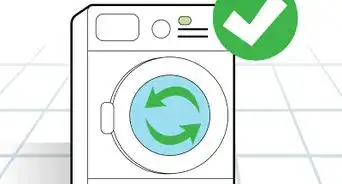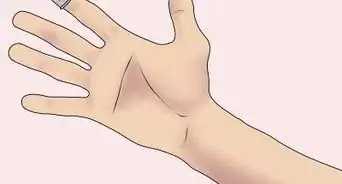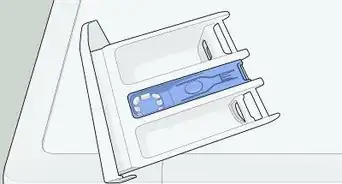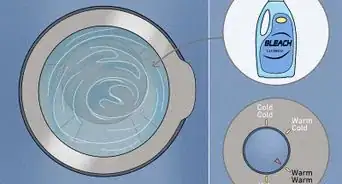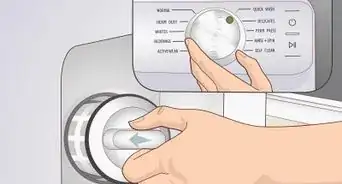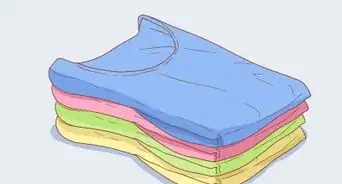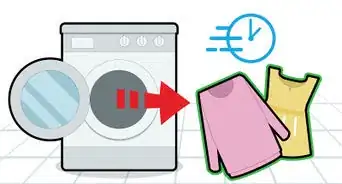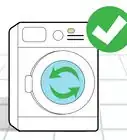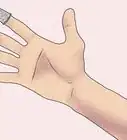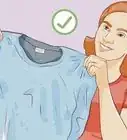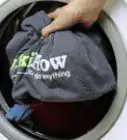This article was co-authored by Robert Shapiro. Robert Shapiro is a Laundry Specialist and the General Manager at Milt & Edie's Drycleaners & Tailoring Center in Burbank, California. With more than a decade of experience, he specializes in dry cleaning, stain removal, tailoring, alterations, and green and eco-friendly cleaning processes. Robert has also been featured in publications such as Cleaner and Launderer Magazine.
There are 8 references cited in this article, which can be found at the bottom of the page.
This article has been viewed 107,237 times.
Chlorine bleach is a popular household chemical that is used for a variety of cleaning purposes. Bleach is commonly used on white towels to remove dirt and stains, and to restore the original bright, white hue. While it is a powerful tool for whitening household towels, it can also be dangerous if not handled properly. However, if you know the proper precautions and follow a few simple steps, you can safely, efficiently bleach towels from the comfort of your home.
Steps
Using Bleach in a Washing Machine
-
1Place the towels you want to bleach into your washing machine. Select the appropriate load size based upon the number of towels you are bleaching. Be careful not to overload the washing machine.
- Laundry that is packed in too tightly will not rotate as freely, and the agitator will not be able to clean it as well.[1]
-
2Set the water temperature to the highest possible setting. Choose a hot water cycle that is 30 minutes or longer. The hotter the water temperature, the cleaner your towels will be.[2]
- Check the care label on the towels for any special instructions. Some towels cannot handle extremely hot water. If this is the case, use the hottest setting recommended on the care label.
Advertisement -
3Use the associated cap to measure the right amount of detergent. If your washing machine has a detergent dispenser, pour the detergent to the “max-fill” line. If your machine does not have a dispenser, add the detergent directly to the hot water as it fills the machine.
- Most laundry detergent bottles have a cap that functions as a measuring device. Read the label on the detergent bottle to know exactly know much detergent you need for the size of the load.
- It’s important to use the right amount of laundry detergent. Too much detergent will cushion the load and decrease cleansing performance, while using too little will keep the towels from being fully cleaned.[3]
-
4Dilute 1⁄2 cup (120 mL) of bleach with 1 US quart (950 mL) of water. Use a large bowl, measuring cup, or bucket to mix the bleach and the water together. The appropriate amount of bleach can vary, so always add bleach according to the instructions on the label.[4]
-
5Add the bleach to the wash 5 minutes after the machine begins agitating. If your washing machine has a bleach dispenser, pour 1⁄2 cup (120 mL) of undiluted bleach to the “max-fill” line. The machine will automatically release the bleach at the appropriate time.[5]
- For front-loading machines that lock once the cycle starts, add the diluted bleach to the load at the same time as the detergent.
-
6Close the washing machine and let the cycle run as usual. Once the towels have run through the cycle and drained, flip them into the dryer or hang them up to dry. If the towels are not as white as you would like, repeat the process until you reach your desired result.
- Skip the fabric softener, as it tends to leave a coating on towels that reduces absorbency and decreases whiteness.[6]
Soaking Your Towels in a Bleach Solution
-
1Pour 1 gallon (3.8 L) of cool water and 1⁄4 cup (59 mL) of bleach into a large bucket. If you have more towels to bleach, you may need more water. Add 1⁄4 cup (59 mL) of bleach for every additional 1 gallon (3.8 L) of water.[7]
- If you have a top loading clothes washer, mix the solution in the washer to prevent splashing the bleach on yourself or your work area. Set the washer to the “small” load setting and let it fill with cool water. Stop it once it starts to agitate. Most washers fill with about 12 gallons (45 L) for the “small” load setting, so add 3 cups (710 mL) of bleach.[8]
-
2Add your towels to the solution and soak for roughly 5 minutes. Submerge the towels completely in the solution. Set a timer for at least 5 minutes and no longer than 10 minutes.
- Gently swirl the towels around every 2-3 minutes to make sure all of the towels get evenly soaked.
- If the water does not cover the towels completely, remove the towels and add 1 gallon (3.8 L) of water and 1⁄4 cup (59 mL) of bleach to the solution. Continue adding solution at this ratio until you can completely submerge the towels.[9]
-
3Wring out the towels to remove any excess solution. When the timer goes off, remove the towels from the solution. Squeeze them several times to drain excess solution until they are no longer soaking wet.
- Wear rubber gloves to protect your skin from harmful chemicals in the bleach solution.
- If you’re using a top loading washer, you don’t have to wring them out manually. Simply advance the dial so that the washer drains on its own.[10]
-
4Wash your bleached towels in a washing machine with detergent. Use the hottest water setting possible. The hotter the water is, the cleaner the towels will be.[11] When the washing machine finishes its cycle, dry them in a dryer or hang them up until are completely dry.
- If you’re using a top load washing machine, add detergent to the dispenser or directly to the towels after they drain. Then, reset the dial to the beginning of the wash cycle and let it run all the way through.
- Check your detergent bottle to know exactly how much to use for the size of the load you’re washing.
-
5Scrub your hands with liquid soap and warm water. Use liquid disinfectant soap and hot water, and scrub for at least 20 seconds. Dry your hands with a clean towel. While using a towel helps remove germs, it’s okay to let them air dry if you don’t have a clean towel.[12]
- If you need a timer, try humming the “Happy Birthday” song while you wash your hands. Scrub your hands for the entire length of the song, then use a clean towel to dry your hands.
- Even if you used gloves to protect your hands, it’s a good idea to wash them properly to remove any bleach that may have gotten inside of the gloves or around your wrists.[13]
Handling Bleach Safely
-
1Never mix bleach with other cleaning products. Mixing bleach with other cleaning products can release harmful toxic gases that can irritate eyes and respiration. In particular, combining bleach with ammonia releases chlorine gas, which can be deadly to inhale.
- If sufficient amounts of bleach and ammonia are mixed together, an explosion may occur.[14]
-
2Wear rubber gloves to protect your hands when handling bleach. The active ingredient in chlorine bleach, sodium hypochlorite, is highly corrosive and can easily damage the skin. Rubber or nitrile gloves can protect you from unnecessary exposure.[15]
- Make sure to wear clothing that will protect your skin from bleach splatters or accidental spills.
- Wear a plastic apron to avoid splashing bleach on your clothing.[16]
- Remove all other garments and fabrics from the area, since any bleach spill might remove their colors.
-
3Mix bleach solutions outdoors or in a well-ventilated room. Open as many windows in the room as possible, and use fans to exchange the air inside the room with the air outside. Bleach contains powerful toxins, and the vapors can build up quickly in small or closed-in rooms.
- Bleach vapors can cause eye or respiratory irritation if they are not dissipated effectively.[17]
-
4Choose a bleach product recommended for use in the laundry. Always check the label of the bleach bottle to make sure the bleach is safe to use in the laundry. Additionally, check the tag on the towels you want to bleach, as some towels will specifically say not to bleach them.
- Chlorine bleach is the most popular form of bleach used for cleaning and may be used to bleach white towels as long as it is properly diluted.
- Use a color-safe bleach containing hydrogen peroxide to bleach colored towels without damaging them.[18] Since this kind of product might not be readily available, it might be a good idea to take your towels to a professional cleaner.
- Never apply chlorine bleach directly to towels, as this can cause them irreversible damage.
Warnings
- If bleach touches the skin, contact a healthcare professional if irritation persists for more than 24 hours.⧼thumbs_response⧽
- Avoid touching your eyes when handling bleach. If bleach gets in your eyes, rinse them immediately for at least 15 minutes.[20]⧼thumbs_response⧽
- Bleach releases a toxic gas when exposed to sunlight, so always store it in a cool, shaded area away from the reach of children.[21]⧼thumbs_response⧽
Things You'll Need
- Bleach that's recommended for use with laundry (preferably chlorine)
- Rubber or nitrile gloves
- A large bucket
- Laundry detergent
- Antibacterial soap
- Washing machine
- Clothes dryer (optional)
References
- ↑ https://www.clorox.com/how-to/fabric-cleaning/bedding/how-do-i-get-my-towels-and-bed-linens-really-bright-white/
- ↑ https://www.clorox.com/how-to/fabric-cleaning/bedding/how-do-i-get-my-towels-and-bed-linens-really-bright-white/
- ↑ https://www.clorox.com/how-to/fabric-cleaning/bedding/how-do-i-get-my-towels-and-bed-linens-really-bright-white/
- ↑ https://www.clorox.com/how-to/fabric-cleaning/bedding/how-do-i-get-my-towels-and-bed-linens-really-bright-white/
- ↑ https://www.cleanipedia.com/gb/laundry/how-to-bleach-clothes.html
- ↑ https://www.clorox.com/how-to/fabric-cleaning/bedding/how-do-i-get-my-towels-and-bed-linens-really-bright-white/
- ↑ https://www.osha.gov/OshDoc/data_Hurricane_Facts/general_decontamination_fact.pdf
- ↑ https://www.clorox.com/how-to/fabric-cleaning/towels/soaking-white-bath-towels/
- ↑ https://www.clorox.com/how-to/fabric-cleaning/towels/soaking-white-bath-towels/
- ↑ ttps://www.clorox.com/how-to/fabric-cleaning/towels/soaking-white-bath-towels/
- ↑ https://www.clorox.com/how-to/fabric-cleaning/bedding/how-do-i-get-my-towels-and-bed-linens-really-bright-white/
- ↑ https://www.osha.gov/OshDoc/data_Hurricane_Facts/general_decontamination_fact.pdf
- ↑ https://www.cdc.gov/features/handwashing/index.html
- ↑ https://www.ag.ndsu.edu/flood/home/chlorine-bleach-safety
- ↑ https://www.ag.ndsu.edu/flood/home/chlorine-bleach-safety
- ↑ https://www.cleanipedia.com/gb/laundry/how-to-bleach-clothes.html
- ↑ https://www.ag.ndsu.edu/flood/home/chlorine-bleach-safety
- ↑ https://www.cleanipedia.com/gb/laundry/how-to-bleach-clothes.html
- ↑ https://www.info.gov.hk/info/sars/en/useofbleach.htm
- ↑ https://www.info.gov.hk/info/sars/en/useofbleach.htm
- ↑ https://www.info.gov.hk/info/sars/en/useofbleach.htm



